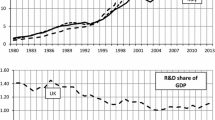Abstract
This paper argues that interactions of firms account for a sizable part of fluctuations in aggregate investments without exogenous aggregate shocks. We first establish empirically that the fraction of firms that engage in a lumpy investment follows a non-normal, two-sided exponential distribution across region-year with a panel data set of Italian firms. We then present a simple sectoral model that generates the two-sided exponential distribution that arises from the complementarity of the firms’ lumpy investments within a region. Calibrated by the firm-level estimate of complementarity, the model is capable of generating the two-sided exponential fluctuations observed at the aggregate level.
Similar content being viewed by others
References
Acemoglu, D., V. M. Carvalho, A. Ozdaglar and A. Tahbaz-Salehi (2012) “The Network Origins of Aggregate Fluctuations”, Econometrica, Vol. 80, pp. 1977–2016.
Bachmann, R., R. J. Caballero and E. M. Engel (2013) “Aggregate Implications of Lumpy Investment: New Evidence and a DSGE Model”, American Economic Journal: Macroeconomics, Vol. 5, pp. 29–67.
Bartelsman, E. J., R. J. Caballero and R. K. Lyons (1994) “Customer- and Supplier-Driven Externalities”, American Economic Review, Vol. 84, pp. 1075–1084.
Brock, W. A. and S. N. Durlauf (2001) “Discrete Choice with Social Interactions”, Review of Economic Studies, Vol. 68, pp. 235–260.
Caballero, R. J. and E. M. R. A. Engel (1991) “Dynamic (S,s) Economies”, Econometrica, Vol. 59, pp. 1659–1686.
Caballero, R. J. and E. M. R. A. Engel (1999) “Explaining Investment Dynamics in U.S. Manufacturing: A Generalized (S,s) Approach”, Econometrica, Vol. 67, pp. 783–826.
Caplin, A. S. and D. F. Spulber (1987) “Menu Cost and the Neutrality of Money”, Quarterly Journal of Economics, Vol. 102, pp. 703–726.
Carvalho, V. M. (2010) “Aggregate Fluctuations and the Network Structure of Intersectoral Trade”, mimeo. Universitat Pompeu Fabra
Cingano, F. and F. Schivardi (2004) “Identifying the Sources of Local Productivity Growth”, Journal of the European Economic Association, Vol. 2, pp. 720–742.
Cooper, R. (1994) “Equilibrium Selection in Imperfectly Competitive Economies with Multiple Equilibria”, Economic Journal, Vol. 104, pp. 1106–1122.
Cooper, R., J. Haltiwanger and L. Power (1999) “Machine Replacement and the Business Cycles: Lumps and Bumps”, American Economic Review, Vol. 89, pp. 921–946.
Doms, M. and T. Dunne (1998) “Capital Adjustment Patterns in Manufacturing Plants”, Review of Economic Dynamics, Vol. 1, pp. 409–429.
Dupor, B. (1999) “Aggregation and Irrelevance in Multi-Sector Models”, Journal of Monetary Economics, Vol. 43, pp. 391–409.
Gabaix, X. (2011) “The Granular Origins of Aggregate Fluctuations”, Econometrica, Vol. 79, pp. 733–772.
Glaeser, E. L., B. I. Sacerdote and J. A. Scheinkman (2003) “The Social Multiplier”, Journal of the European Economic Association, Vol. 1, pp. 345–353.
Gourio, F. and A. K. Kashyap (2007) “Investment Spikes: New Facts and a General Equilibrium Exploration”, Journal of Monetary Economics, Vol. 54, pp. 1–22.
Guiso, L., C. Lai and M. Nirei (2011) “Detecting Propagation Effects by Observing Aggregate Distributions: The Case of Lumpy Investments”, European University Institute Working Papers, ECO 2011/25.
Guiso, L. and F. Schivardi (2007) “Spillovers in Industrial Districts”, Economic Journal, Vol. 117, pp. 68–93.
Harris, T. E. (1989) The Theory of Branching Processes, NY: Dover.
Horvath, M. (2000) “Sectoral Shocks and Aggregate Fluctuations”, Journal of Monetary Economics, Vol. 45, pp. 69–106.
Jovanovic, B. (1987) “Micro Shocks and Aggregate risk”, Quarterly Journal of Economics, Vol. 102, pp. 395–410.
Long, J. B. Jr. and C. I. Plosser (1983) “Real Business Cycles”, Journal of Political Economy, Vol. 91, pp. 39–69.
Lucas, R. E. Jr. (1981) Studies in Business-cycle Theory, Cambridge, MA: MIT Press.
Manski, C. F. (1993) “Identification of Endogenous Social Effects: The Reflection Problem”, Review of Economic Studies, Vol. 60, pp. 531–542.
Nirei, M. (2006) “Threshold Behavior and Aggregate Fluctuation”, Journal of Economic Theory, Vol. 127, pp. 309–322.
Nirei, M. (2015) “An Interaction-Based Foundation of Aggregate Investment Fluctuations”, Theoretical Economics, Vol. 10, pp. 953–985.
Shea, J. (1993) “The Input–Output Approach to Instrument Selection”, Journal of Business and Economic Statistics, Vol. 11, pp. 145–155.
Shea, J. (2002) “Complementarities and Comovements”, Journal of Money, Credit and Banking, Vol. 34, pp. 412–433.
Thomas, J. K. (2002) “Is Lumpy Investment Relevant for the Business Cycle?”, Journal of Political Economy, Vol. 110, No. 3, pp. 508–534.
Vives, X. (1990) “Nash Equilibrium with Strategic Complementarities”, Journal of Mathematical Economics, Vol. 19, pp. 305–321.
Vuong, Q. H. (1989) “Likelihood Ratio Tests for Model Selection and Non-Nested Hypotheses”, Econometrica, Vol. 57, pp. 307–333.




